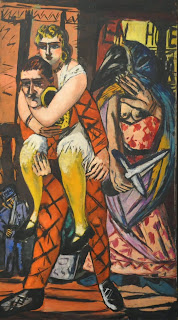Do you know what this latin phrase means? It is on all of your coins. It's on the Seal of the United States.
It means: Out of many, one. It refers to the fact that the United States was formed as one nation as a result of the thirteen smaller colonies joining together. In recent years its meaning has also come to suggest that out of many peoples, races, religions and ancestries has emerged a single nation.
This was one of the fascinating tidbits of information we learned on our visit to the U.S. Capitol building.
To visit the Capitol building, you enter through the Capitol Visitor Center...
Walking towards the visitor's center, we get our first glimpse of the Capitol Dome...
You must schedule a specific time to tour the Capitol Building. It is free, but you must book the tour in advance. We were early for our tour so we walked around the outside. It was an cloudy Saturday morning so there was hardly anyone else around.
 Such beautiful detailing in the architecture...
Such beautiful detailing in the architecture...
The dome is topped with the bronze statue of Freedom. Amazingly, the statue is 19 feet 6 inches tall and weighs approximately 15,000 pounds. She stands on a cast-iron pedestal on a globe encircled with the motto E Pluribus Unum.
Ironically the man who played a key role in the creation of the Freedom statue was at the time a slave. Whether or not he saw the last piece of the Statue of Freedom put into place on December 2, 1863, Philip Reid was by that time a free man who became a master craftsman and artisan. You can read about him here.
Click here to learn more about scheduling a tour of the U.S. Capitol.
In my next blog post I will take you inside the Capitol and the beautiful dome.
All photos in this blog post were taken by my husband and me during our visit in September, 2013.
It means: Out of many, one. It refers to the fact that the United States was formed as one nation as a result of the thirteen smaller colonies joining together. In recent years its meaning has also come to suggest that out of many peoples, races, religions and ancestries has emerged a single nation.
This was one of the fascinating tidbits of information we learned on our visit to the U.S. Capitol building.
To visit the Capitol building, you enter through the Capitol Visitor Center...
You must schedule a specific time to tour the Capitol Building. It is free, but you must book the tour in advance. We were early for our tour so we walked around the outside. It was an cloudy Saturday morning so there was hardly anyone else around.
 Such beautiful detailing in the architecture...
Such beautiful detailing in the architecture...The dome is topped with the bronze statue of Freedom. Amazingly, the statue is 19 feet 6 inches tall and weighs approximately 15,000 pounds. She stands on a cast-iron pedestal on a globe encircled with the motto E Pluribus Unum.
Ironically the man who played a key role in the creation of the Freedom statue was at the time a slave. Whether or not he saw the last piece of the Statue of Freedom put into place on December 2, 1863, Philip Reid was by that time a free man who became a master craftsman and artisan. You can read about him here.
Click here to learn more about scheduling a tour of the U.S. Capitol.
In my next blog post I will take you inside the Capitol and the beautiful dome.
All photos in this blog post were taken by my husband and me during our visit in September, 2013.






























































